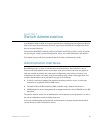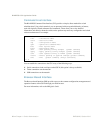BLADEOS 6.5.2 Application Guide
BMD00220, October 2010 Preface 19
Part 5: IP Routing
Chapter 15, “Basic IP Routing,” describes how to configure the G8124 for IP routing using IP
subnets, BOOTP, and DHCP Relay.
Chapter 16, “Internet Protocol Version 6,” describes how to configure the G8124 for IPv6 host
management.
Chapter 17, “Routing Information Protocol,” describes how the BLADEOS software
implements standard Routing Information Protocol (RIP) for exchanging TCP/IP route
information with other routers.
Chapter 18, “Internet Group Management Protocol,” describes how the BLADEOS software
implements IGMP Snooping or IGMP Relay to conserve bandwidth in a multicast-switching
environment.
Chapter 19, “Border Gateway Protocol,” describes Border Gateway Protocol (BGP) concepts
and features supported in BLADEOS.
Chapter 20, “OSPF,” describes key Open Shortest Path First (OSPF) concepts and their
implemented in BLADEOS, and provides examples of how to configure your switch for OSPF
support.
Chapter 21, “Protocol Independent Multicast,” describes how multicast routing can be
efficiently accomplished using the Protocol Independent Multicast (PIM) feature.
Part 6: High Availability Fundamentals
Chapter 22, “Basic Redundancy,” describes how the G8124 supports redundancy through
trunking, Active Multipass Protocol (AMP), and hotlinks.
Chapter 23, “Layer 2 Failover,” describes how the G8124 supports high-availability network
topologies using Layer 2 Failover.
Chapter 24, “Virtual Router Redundancy Protocol,” describes how the G8124 supports
high-availability network topologies using Virtual Router Redundancy Protocol (VRRP).
Part 7: Network Management
Chapter 25, “Link Layer Discovery Protocol,” describes how Link Layer Discovery Protocol
helps neighboring network devices learn about each others’ ports and capabilities.
Chapter 26, “Simple Network Management Protocol,” describes how to configure the switch
for management through an SNMP client.


















